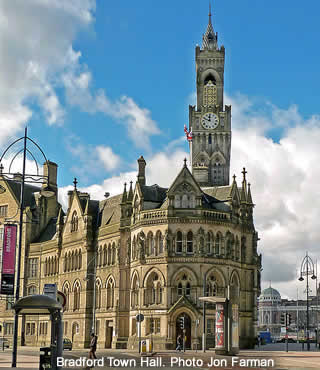Bradford |
|
 |
|||
Both the UK's City of Film, and its Curry Capital |
|||||
|
|||||
When the year 1800 came around, Bradford was a relatively small market town with 16,000 residents. It made its money from wool spinning and cloth weaving. Over the next few decades these industries exploded, and Bradford became both busy and rich. By 1850 it housed 182,000 people, and was known as the wool capital of the world. |
|||||
The vast wealth that poured into the town at that time has left its mark. Most obviously is 1873's Town Hall, an ornate Gothic structure with a colossal tower. Just a couple of decades after its opening the place had to be renamed, as Bradford had grown large enough to earn official city status. The Town Hall was rechristened as the City Hall, and given a £12,000 makeover to celebrate. |
|||||
The tower's bells can be heard all across the neighbouring market square, and beyond. They're controlled by computers, which can be programmed to play anything at all. They played the Coronation Street theme when the cast were filming nearby, and the Star Spangled Banner in honour of those killed by terrorism. |
|||||
Another mark left by the wool trade is Little Germany, so named because it was constructed by rich German merchants. The area contains 85 buildings altogether. They're no longer used to store wool, but they've maintained their Victorian architecture, and they're still used by the city's most successful businesses. 55 of the properties have official listed status. |
|||||
Another building of similar age is Cartwright Hall. Since 1904 it's been Bradford's main art gallery. Its original collection was mainly comprised of Victorian works, but it has since expanded to include everything from ancient sculpture to contemporary media. The hall's surrounded by the open lawns and beautiful water gardens of Lister Park. |
|||||
The development of Bradford since its 19th century transformation is explained at the Industrial Museum, with demonstrations of working textile and printing machinery. There are plenty of photographs, tools and, of course, displays of the products which were actually produced. The exhibits then begin to move forward in time, covering more modern developments like motorised transport. |
|||||
The most celebrated museum of all, however, is surely the National Media Museum. This huge, modern complex contains 7 permanent exhibitions on the development of photography, film and video games. There are frequent guest exhibitions, three cinemas, a café, and much more besides. The BBC own offices here, and the University of Bradford teach courses on the premises. The museum helps to organise two festivals every year, one on animation and one on film in general. Almost everything, aside from movie screenings and special exhibitions, is free. It's no wonder, then, that this is the most popular museum outside London, with well over half a million visitors a year. |
|||||
|
|||||
|
Pocket Britain is optimised for use on a smartphone or tablet with internet access. All content is subject to copyright. All reasonable methods have been used to ensure information supplied is accurate at the time of publication. However, it is advisable to check information before relying on it. Privacy Policy |